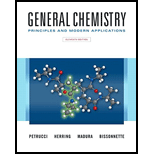
Concept explainers
(a)
Interpretation:
The value of
Concept introduction:
For a solution, pH can be calculated as follows:
Here,
In an
If oxidation takes place on an electrode, that electrode is called anode. The species in that electrode remove electrons anditself gets oxidized.
If reduction takes place on an electrode, that electrode is called cathode. The species in that electrode absorbs electrons and itself gets reduced.
The electrode potential of cell can be calculated as follows:
Nernst equation for a cell can be represented as follows:
Here,
z = number of moles of electrons transferred in the cell and Q is ratio of concentration of products to reactant in a cell.
(b)
Interpretation:
The value of
Concept introduction:
In an electrochemical cell, there are two electrodes that can be observed.
If oxidation takes place on an electrode, that electrode is called anode. The species in that electrode remove electrons and itself gets oxidized.
If reduction takes place on an electrode, that electrode is called cathode. The species in that electrode absorbs electrons and itself gets reduced.
The electrode potential of cell can be calculated as follows:
Nernst equation for a cell can be represented as follows:
Here,
z = number of moles of electrons transferred in the cell and Q is ratio of concentration of products to reactant in a cell.
(c)
Interpretation:
The value of
Concept introduction:
The acetic acid, CH3COOH is weak acid. Therefore, partially dissociates into ions in water.
In an electrochemical cell, there are two electrodes that can be observed.
If oxidation takes place on an electrode, that electrode is called anode. The species in that electrode remove electrons and itself gets oxidized.
If reduction takes place on an electrode, that electrode is called cathode. The species in that electrode absorbs electrons and itself gets reduced.
The electrode potential of cell can be calculated as follows:
Nernst equation for a cell can be represented as follows:
Here,
z = number of moles of electrons transferred in the cell and Q is ratio of concentration of products to reactant in a cell.
Want to see the full answer?
Check out a sample textbook solution
Chapter 19 Solutions
Generl Chem Looself&mod Mst/et&stdy Crd Pkg, 11/e
- What is the standard cell potential you would obtain from a cell at 25C using an electrode in which Hg22+(aq) is in contact with mercury metal and an electrode in which an aluminum strip dips into a solution of Al3+(aq)?arrow_forwardFor each reaction listed, determine its standard cell potential at 25 C and whether the reaction is spontaneous at standard conditions. (a) Mn(s)+Ni2+(aq)Mn2+(aq)+Ni(s) (b) 3Cu2+(aq)+2Al(s)2Al3+(aq)+3Cu(s) (c) Na(s)+LiNO3(aq)NaNO3(aq)+Li(s) (d) Ca(NO3)2(aq)+Ba(s)Ba(NO3)2(aq)+Ca(s)arrow_forwardFor each of the reactions, calculate E from the table of standard potentials, and state whether the reaction is spontaneous as written or spontaneous in the reverse direction under standard conditions. (a) Zn(s)+Fe2+(aq)Zn2+(aq)+Fe(s) (b) AgCl(s)+Fe2+(aq)Ag(s)+Fe3+(aq)+Cl(aq) (c) Br2(l)+2Cl(aq)Cl2(g)+2Br(aq)arrow_forward
- What is the standard cell potential you would obtain from a cell at 25C using an electrode in which I(aq) is in contact with I2(s) and an electrode in which a chromium strip dips into a solution of Cr3(aq)?arrow_forwardAn electrolysis experiment is performed to determine the value of the Faraday constant (number of coulombs per mole of electrons). In this experiment, 28.8 g of gold is plated out from a AuCN solution by running an electrolytic cell for two hours with a current of 2.00 A. What is the experimental value obtained for the Faraday Constant?arrow_forwardCalculate the standard cell potential of the cell corresponding to the oxidation of oxalic acid, H2C2O4, by permanganate ion. MnO4. 5H2C2O4(aq)+2MnO4(aq)+6H+(aq)10CO2(g)+2Mn2+(aq)+8H2O(l) See Appendix C for free energies of formation: Gf for H2C2O4(aq) is 698 kJ.arrow_forward
- The half-cells Ag+(aq. 1.0 M)|Ag(s) and H+(aq, ? M)|H2(1.0 bar) are linked by a salt bridge to create a voltaic cell. With the silver electrode as the cathode, a value of 0.902 V is recorded tor kcell at 298 K. Determine the concentration of H+ and the pH of the solution.arrow_forwardElectrolysis of a solution of CuSO4(aq) to give copper metal is carried out using a current of 0.66 A. How long should electrolysis continue to produce 0.50 g of copper?arrow_forwardCalculate the cell potential of a cell operating with the following reaction at 25C, in which [MnO4] = 0.010 M, [Br] = 0.010 M. [Mn2] = 0.15 M, and [H] = 1.0 M. 2MNO4(aq)+10Br(aq)+16H+(aq)2MN2(aq)+5Br2(l)+8H2O(l)arrow_forward
- For a certain cell, G=25.0 kJ. Calculate E° if n is (a) 1(b)1(c) 41 Comment on the effect that the number of electrons exchanged has on the voltage of a cell.arrow_forwardAn aqueous solution of an unknown salt of gold is electrolyzed by a current of 2.75 amps for 3.39 hours. The electroplating is carried out with an efficiency of 93.0%, resulting in a deposit of 21.221 g of gold. a How many faradays are required to deposit the gold? b What is the charge on the gold ions (based on your calculations)?arrow_forward
 Chemistry: The Molecular ScienceChemistryISBN:9781285199047Author:John W. Moore, Conrad L. StanitskiPublisher:Cengage Learning
Chemistry: The Molecular ScienceChemistryISBN:9781285199047Author:John W. Moore, Conrad L. StanitskiPublisher:Cengage Learning Chemistry: Principles and ReactionsChemistryISBN:9781305079373Author:William L. Masterton, Cecile N. HurleyPublisher:Cengage Learning
Chemistry: Principles and ReactionsChemistryISBN:9781305079373Author:William L. Masterton, Cecile N. HurleyPublisher:Cengage Learning General Chemistry - Standalone book (MindTap Cour...ChemistryISBN:9781305580343Author:Steven D. Gammon, Ebbing, Darrell Ebbing, Steven D., Darrell; Gammon, Darrell Ebbing; Steven D. Gammon, Darrell D.; Gammon, Ebbing; Steven D. Gammon; DarrellPublisher:Cengage Learning
General Chemistry - Standalone book (MindTap Cour...ChemistryISBN:9781305580343Author:Steven D. Gammon, Ebbing, Darrell Ebbing, Steven D., Darrell; Gammon, Darrell Ebbing; Steven D. Gammon, Darrell D.; Gammon, Ebbing; Steven D. Gammon; DarrellPublisher:Cengage Learning Chemistry: Principles and PracticeChemistryISBN:9780534420123Author:Daniel L. Reger, Scott R. Goode, David W. Ball, Edward MercerPublisher:Cengage LearningChemistry: Matter and ChangeChemistryISBN:9780078746376Author:Dinah Zike, Laurel Dingrando, Nicholas Hainen, Cheryl WistromPublisher:Glencoe/McGraw-Hill School Pub Co
Chemistry: Principles and PracticeChemistryISBN:9780534420123Author:Daniel L. Reger, Scott R. Goode, David W. Ball, Edward MercerPublisher:Cengage LearningChemistry: Matter and ChangeChemistryISBN:9780078746376Author:Dinah Zike, Laurel Dingrando, Nicholas Hainen, Cheryl WistromPublisher:Glencoe/McGraw-Hill School Pub Co





